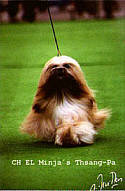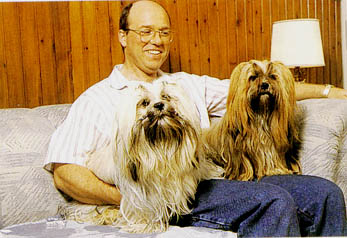|
|
| Heupaandoeningen
grote rassen heupluxaties en heupdysplasie.
Universiteit Gent |
|
| Heupaandoeningen die
kunnen voorkomen bij kleine rassen zijn Legg-Perthes-Calvé,
fracturen ter hoogte van de femurkop of -nek, heupluxaties en heupdysplasie.
Over heupdysplasie bij kleine hondenrassen is er weinig beschreven. |
|
| Genetische achtergrond van Dwerggroei bij honden en de Duitse Herder | |
| Gecombineerde diagnostiek van erfelijke skeletaandoeningen | |
| Welke kenmerken of aandoeningen mag hij of zij als erfelijk beschouwen, voordracht Syntra | |
| Cherry Eye of kerseoog bij de hond door Dr Gerlinde Janssens | |
| Het gedrag van de Hond, genetische component wetenschappelijke benadering over het gedrag van de hond Publikatie over gedrag en erfelijkheid. | |
| Universiteit van Gent: Breedcouncil en Belgische Wetenschappelijke Vereniging voor diagnose van erfelijke afwijkingen. Publikatie over gedrag en erfelijkheid.Frank van Tatenhove | |
Mutaties: Beschrijving van de overerving van mutaties, wat zijn mutaties, en zijn ze schadelijk of niet als zodanig en in welke vormen komen ze voor. Door Dr. J.Armstrong en F van Tatenhove |
|
| Cataract: Beschrijving van de verschillende Cataract vormen , door Dr.Gerlinde Janssens. | |
| Universiteit van Gent: GENETISCHE AFWIJKINGEN BIJ DE HOND (CANIS FAMILIARIS) EN HUN MOLECULAIR GENETISCHE EN BIOCHEMISCHE KARAKTERISATIE door, Prof.Dr. L.J.Peelman, Prof. Dr. A. Van Zeveren, Dr. F. Coopman, Prof. Dr. Y. Bouquet | |
| Erfelijkheid: " erfelijkheid bij honden " in de nederlandse taal. Scriptie van Dr Leonie Van Balen ,Promotor Dr Frank Coopman, | |
| Gangwerk : artikel over het gangwerk bij honden, door Frank van Tatenhove | |
| Fokkerij door Frank van Tatenhove, uitleg over erfelijkheid voor de beginnende en gevorderde fokker. | |
|
|
|
| Cherry eye by the dog by Dr Gerlinde Janssens | |
| Canine Genetics: Dr John B. Armstrong's " The Canine Diversity Project". / honden genetica website | |
| PRA: compiled article about eye defect by the Lhasa Apso by Frank van Tatenhove | |
| Optimal Project: Vet Gen research information on the Canine genes and eye diseases | |
| Breed Value: The breed value assesment is developed by Dr. Reiner Beuing of the Institute for animal husbandry and domestic animal genetics of the University of Gießen an review. Explanation of the Breed Value Assessment | |
| Research: CURRENT RESEARCH IN PROGRESSIVE RETINAL ATROPHY by Dr Greg Acland and Dr Gustavo Aguirre Caspary Professor of Ophthalmology Center for Canine Genetics & Reproduction | |
| Breeding Schemes: by Dr. John B. Armstrong fokschema's voor het gezonder en beter fokken van honden. | |
| Mutations: by Dr.John B. Armstrong all about mutations | |
| Gregor Mendel: By Frank van Tatenhove Who was Gregor Mendel? | |
ARTICLE ABOUT MOVEMENT !!!
Movements of the
Dog by
Frank van Tatenhove
|
![]()
Most of you are undoubtedly aware that color and certain diseases such as progressive retinal atrophy (PRA) are inherited that is, passed down from one or both the parents. However, you may wonder how a trait that does not appear in the dam's pedigree can suddenly turn up in a litter out of Ch. Jacob Hugelsberg. Is it inherited or just an accident? Surely, Jake has been used so often that someone would have noticed if the problem came from him. Just how much of a role does genetics play in health, general conformation and temperament? Probably, you would like to know exactly what traits are inherited; but, once someone starts talking about "partial dominance" or "expressivity," you get glassy-eyed. The objective of this guide is to explain some of the basics of inheritance and how to use these concepts to breed healthier dogs — hopefully without losing you in complex technical jargon. What Traits (or Characteristics) Are Inherited?The answer is "almost all," from temperament to size and coloring, as well as genetic diseases like progressive retinal atrophy (PRA). Infectious diseases are not inherited, though the susceptibility to them may be, to a greater or lesser extent. The occurrence of any particular characteristic depends on two factors: genetics and the environment. "Genetics" refers to the encoded information (instructions) controlling all biological processes that are carried within the cells of all living organisms. These encoded instructions are responsible not only for maintaining the continuity of a species (or breed), but also for many of the differences between individuals within a species or breed. The environment also contributes to the differences between individuals. The relative contribution of genetics and environment is not the same for every trait. Some traits, such as color, are influenced very little by the environment. For others, such as temperament, the effect of the environment is much greater. Geneticists use the term heritability to indicate the proportion of the total possible variability in a trait that is genetic. However, when genetic differences are not the main source of variability, the heritability of a trait may be difficult to establish and may not be the same for different breeds. Therefore, I cannot tell you that the heritability of size, for example, is 70% (or whatever it may be). Before moving on to a more detailed discussion of genetics, I would like to take a brief look at what is meant by "environment," in the present context. For a puppy, the first environment it encounters is that of the mother's womb. Is the mother well nourished, healthy, and free from stress? How old is she? Is this her first litter? How big is the litter? Once the puppy is born, it experiences a new environment, where it has to compete for food and attention. Litter size is still a factor. How much food does the puppy get? How much attention does it get from the mother, the breeder, and the eventual owner? Does it have a safe and healthy environment? Does it have other dogs to associate with? The answers to these questions define, in part, the puppy's environment. Dr Amstrong Frank van Tatenhove |
Dutch kennel Lhasa Apso homepage and Belgium Topkennel Lhasa Apso homepage
Lhasa Apso news from kennel ! dog breeder Lhasa Apso blog Lhasa Apso information source blog
lhasa apso puppies for sale, dogs kennel
El Minja dog kennels and breeder has puppies for sale; check out our puppy pictures

